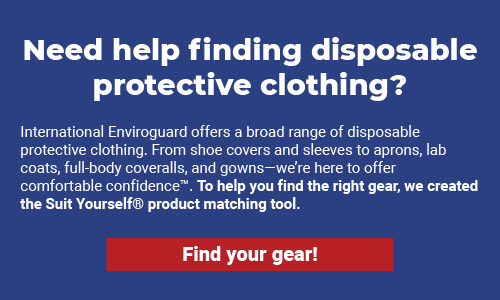
Many thousands of workers wear disposable protective clothing each day. These workers change out for a new set of clothing multiple times a day. What happens to all those disposable personal protective equipment (PPE) garments after they have been used? First, all PPE, including disposable protective clothing, must be stored according to the manufacturer’s specifications so it’s in good shape when put into use. This means keeping it in its original packaging and protecting it from chemicals, sunlight, extreme temperatures, excessive humidity, and moisture. Failure to properly store disposable PPE could render it unusable, in which case you would have to dispose of it before it ever had a chance to be used.
Disposable Means One-Time Use
It’s important to understand is that when it comes to disposable protective clothing, it must be discarded after being used. You should not wash it or disinfect it and reuse it because that process could damage its protective properties and render the item ineffective. Also, depending on the environment in which the disposable PPE garments are used, they could be contaminated with whatever substances you’re intending to be protected from. Whether it’s body fluids, chemicals, asbestos, or other hazardous wastes the wearer should always assume the disposable protective clothing is has been contaminated.
Disposing of Contaminated Disposable Protective Clothing
Employee training on how to properly remove disposable PPE garments is important because if you’re not careful as you remove the clothing, you could expose yourself to the contaminants. Since the disposable clothing is now contaminated, it should be disposed of according to guidelines from appropriate government agencies or advisory bodies. Note that disposable gloves are included in all such guidelines, and it is critical that disposable gloves never be used more than once.
The Centers for Disease Control and Prevention (CDC) and the Food and Drug Administration (FDA) note that dental healthcare professionals, workers in microbiological and biomedical laboratories, and healthcare providers in medical settings (doctors, nurses, etc.) should treat their disposable protective clothing as biohazardous medical waste and it should be disposed of according to state regulations.
The Environmental Protection Agency (EPA) notes that disposable protective clothing worn for mold remediation should be removed in a decontamination chamber and placed in sealed bags, then disposed of as hazardous waste. For heavy pesticide applications in agricultural settings, contaminated disposable PPE garments should be disposed of according to directions on the pesticide product label and all federal, state, and local regulations. In the absence of specific label directions or government regulations, dispose of contaminated PPE as household hazardous waste, which can be taken to an appropriate waste collection event or disposal site.
The Occupational Safety and Health Administration (OSHA) notes that when it comes to hazardous substances, there is no “one size fits all” approach to decontamination and disposal of disposable PPE garments because the protocols and procedures have to be tailored to the particular hazardous material being dealt with. Employers should train all workers on the proper use and disposal of disposable protective clothing based on the nature of the hazardous substances to which workers may be exposed and provide the proper collection containers, such as drums or suitably lined trash cans, for storing disposable clothing that must be discarded.
Recycling Disposable Protective Clothing
There are many instances in which disposable PPE garments are not contaminated by anything other than normal dirt and dust. In those cases, it’s worth the time and effort to participate in a disposable protective clothing recycling program in order to reduce the rather large environmental impact of all that PPE ending up in landfills where it will never biodegrade.
If you have a significant quantity of disposable protective clothing that is discarded on a regular basis and is not contaminated with hazardous substances, a potential company for recycling these items is TerraCycle with their innovative zero waste boxes. All you have to do is order up as many of their box containers as you need, fill them up with your company’s discarded PPE garments and ship full boxes back to TerraCycle. The company sorts through the waste either by hand or mechanically to separate it out by type (if needed) and then either upcycles or recycles as needed. TerraCycle can accept discarded disposable garments, chemical protection suits, flame resistant suits, smocks and nitrile gloves. Do not include the following items: Protective masks, eyewear, respirators, hard hats, household hazardous waste such as lithium ion batteries, pressurized canisters, pesticides, paint or medical sharps.
As many companies step up their environmental and sustainability commitments, the world of PPE and disposable protective clothing is one area ripe for improvement.
International Enviroguard’s high-quality disposable protective clothing is used in a wide range of industries, including companies in industrial/manufacturing, oil and gas, environmental remediation, nuclear, healthcare, semiconductor, pharmaceuticals and food processing. Our disposable protective clothing products provide effective solutions in environments that include dust and particles, sparks or flame, chemical splashes, remediation, infectious diseases, controlled environments, and more.
When you want to protect your workers while maintaining their comfort and productivity, contact us to learn more about our products and our network of distributors serving your market.

